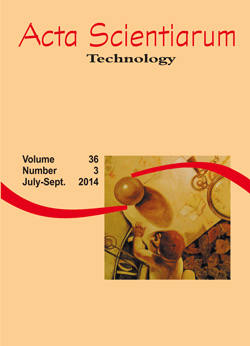<b>The use of sodium alginate-based coating and cellulose acetate in papaya post-harvest preservation
DOI:
https://doi.org/10.4025/actascitechnol.v36i3.17645Keywords:
coating, ripening, storageAbstract
This study aimed to evaluate the ripening of papaya fruit (Carica papaya L.) at room temperature (±25°C) and10°C with 80% relative humidity, coated with edible film based on sodium alginate (1%) and cellulose acetate film (3%) by dipping the fruit in the suspensions for 1 min. On the application of the treatment and every three days during 12 days of storage, fruit were evaluated for weight loss, firmness, total carotenoid content, lycopene content and vitamin C content of the pulp. The cellulose acetate film extended the shelf-life of papayas, without affecting their quality. This treatment delayed fruit ripening, whose changes in all the parameters analyzed were significantly slower than fruit treated with sodium alginate-based coating. The coating with cellulose acetate at 3% was more effective in the preservation of papaya stored for 12 days under both temperatures.
Downloads
Downloads
Published
How to Cite
Issue
Section
License
DECLARATION OF ORIGINALITY AND COPYRIGHTS
I Declare that current article is original and has not been submitted for publication, in part or in whole, to any other national or international journal.
The copyrights belong exclusively to the authors. Published content is licensed under Creative Commons Attribution 4.0 (CC BY 4.0) guidelines, which allows sharing (copy and distribution of the material in any medium or format) and adaptation (remix, transform, and build upon the material) for any purpose, even commercially, under the terms of attribution.
Read this link for further information on how to use CC BY 4.0 properly.



















8.png)




